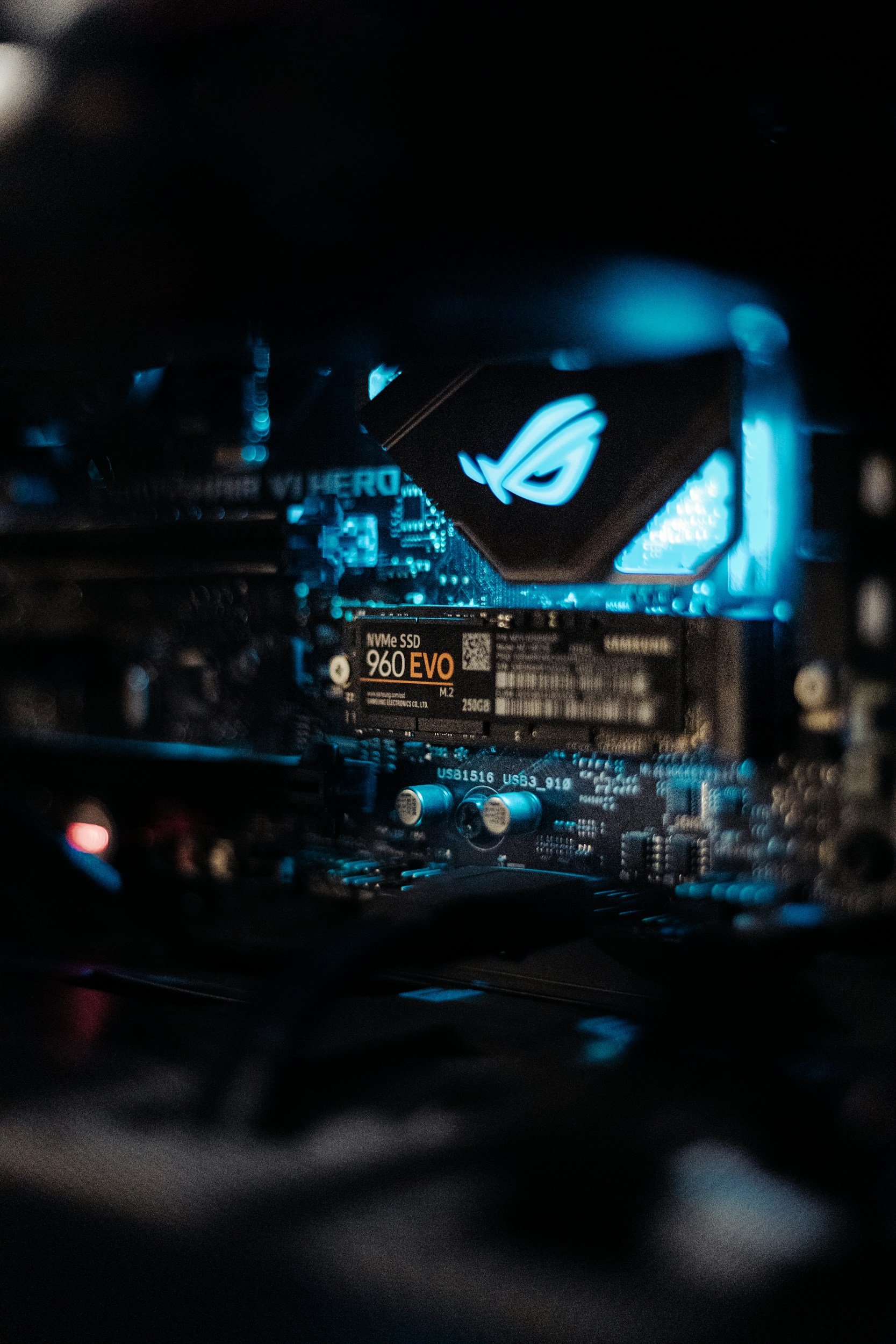How to Format an SSD (Windows & macOS)
When you purchase through links on my site, I may earn an affiliate commission. Here’s how it works.
Table of Contents Show
If you're reading this, chances are you've got your hands on a shiny new SSD, or maybe you're just looking to give your existing one a fresh start. Either way, you're in the right place.
In this guide I will teach you how to format your SSD. Don't worry, it's not rocket science. I'll walk you through the process step-by-step, so you can get your SSD up and running in no time.
Why Formatting Matters in the First Place
Now, before you start loading up your SSD with all your precious data, there's one crucial step you can't skip: formatting. It's like giving your SSD a clean slate, ensuring it's optimized for peak performance and data integrity.
Think of it like setting up a new house. You wouldn't just move in without cleaning and organizing the space, right? Formatting does the same thing for your SSD, creating a file system that tells your computer how to store and retrieve data efficiently.
When to Format
There are a few scenarios where you'll definitely want to format your SSD:
1. Brand New SSD
Fresh out of the box, it's likely unformatted or has a file system incompatible with your operating system.
2. Reinstalling Your OS
A clean install often requires formatting the drive to get rid of any old system files and ensure a smooth setup.
3. Repurposing the Drive
If you're switching from Windows to macOS, or just want to use the SSD for a different purpose, formatting is the way to go.
4. Troubleshooting
Sometimes, formatting can help resolve performance issues or data corruption problems.
What Is SSD Formatting?
Okay, so we've established that formatting your SSD is important. But what exactly is formatting, and why isn't just deleting everything enough?
Think of your SSD like a giant library. When you delete files, it's like removing a few books from the shelves. The books are gone, but the shelves and the catalog system remain.
Formatting, on the other hand, is like tearing down the entire library and rebuilding it from scratch. It wipes out the old catalog system (called the file system) and creates a brand new one, ready to organize your data in a fresh, efficient way.
Quick Format vs. Full Format
Now, there are two main types of formatting: quick format and full format. It's like choosing between a quick tidy-up and a deep clean for your house.
Quick Format
This is like a quick spring cleaning. It essentially just wipes the file system, making it look like the drive is empty. However, your old data is still technically there, hidden beneath the surface, until new data overwrites it. It's great when you need to quickly erase a drive and don't have privacy concerns.
Full Format
This is the thorough approach. It not only wipes the file system but also scans the entire drive for bad sectors (kind of like checking for cracks in the foundation of your library). It takes longer, but it ensures data integrity and can even help identify potential issues with your SSD.
Which One to Choose?
Quick Format
Ideal for new SSDs, reinstalling your OS, or when you simply need to erase the drive quickly.
Full Format
Recommended if you're concerned about data security, repurposing an old drive, or troubleshooting potential issues.
TRIM
One more thing worth mentioning is TRIM. It's a command that tells your SSD which blocks of data are no longer in use, so it can clean them up in the background. This helps maintain SSD performance and longevity. Most modern operating systems support TRIM automatically, but it's worth double-checking that it's enabled.
How to Prepare Your SSD for Formatting
Alright, before we jump into the actual formatting process, let's make sure we're prepared. We want to ensure everything goes smoothly and, most importantly, that we don't lose any precious data.
1. Back Up, Back Up, Back Up!
I cannot stress this enough. Formatting your SSD is like hitting the reset button – everything on it will be wiped clean. So, before you do anything else, make sure you have a secure backup of all your important files. Photos, videos, documents, music – anything you don't want to lose forever.
There are plenty of ways to back up your data. You can use an external hard drive, cloud storage services like Google Drive or Dropbox, or even a trusty USB flash drive if you're dealing with smaller files. Just make sure your backup is complete and up-to-date before proceeding.
2. Choose Your Formatting Tool
The good news is, you don't need any fancy software to format your SSD. Both Windows and macOS have built-in utilities that get the job done.
Windows
You have two main options:
Disk Management: This is the graphical, user-friendly way to go. It's like the point-and-click interface for managing your drives.
Diskpart: If you're comfortable with the command line, Diskpart gives you more granular control. It's like the power user's tool.
macOS
Disk Utility is your one-stop shop for all things disk-related, including formatting. It's pretty straightforward and easy to use.
Third-Party Tools
If you're looking for more advanced features or prefer a different interface, there are plenty of third-party partitioning and disk management tools out there.
EaseUS Partition Master and MiniTool Partition Wizard are a couple of popular options.
3. Connect Your SSD
Finally, let's make sure your SSD is properly connected to your computer.
Internal SSD
If you're installing a new internal SSD, you'll need to open up your computer case and connect it to the appropriate SATA or NVMe slot on your motherboard. Make sure it's securely fastened.
External SSD
If you have an external SSD, simply plug it into a USB port on your computer. It should show up as a new drive in your file explorer.
Once your SSD is connected and your data is backed up, you're ready to start the formatting process. But before we do that, let's quickly recap:
Backup your data
Seriously, don't skip this step!
Choose your formatting tool
Windows (Disk Management or Diskpart), macOS (Disk Utility), or a third-party tool.
Connect your SSD
Make sure it's properly connected to your computer.
Alright, now that we're all prepped and ready, let's move on to the main event: formatting your SSD.
How to Format Your SSD on Windows
First, we're going to walk through the process of formatting your SSD on Windows, using both the graphical Disk Management tool and the command-line Diskpart utility. Don't worry, I'll break it down step-by-step, and we'll have your SSD formatted and ready to roll in no time.
Method 1: Disk Management (The Easy Way)
This is the go-to method for most users. It's visual, intuitive, and doesn't require any command-line wizardry.
Open Disk Management
Right-click on the Start button and select "Disk Management." You'll see a list of all the drives connected to your computer.
Locate Your SSD
Find your SSD in the list. It might be labeled as "Disk 1" or something similar. If it's a new drive, it might show up as "Unallocated."
Right-Click and Select "Format"
Right-click on the SSD and choose "Format." A window will pop up with formatting options.
Choose Your Settings
Volume label: Give your SSD a name (e.g., "Main Drive" or "Storage").
File system: Choose the appropriate file system for your needs (NTFS for Windows, exFAT for cross-platform compatibility).
Allocation unit size: Leave this at the default unless you have a specific reason to change it.
Perform a quick format: Check this box for a faster format. Uncheck it for a full format (recommended for new or repurposed drives).
Click "OK"
Double-check that you've selected the correct drive and settings, then click "OK" to start the formatting process.
Wait For It to Complete
The formatting process might take a few minutes, depending on the size of your SSD and the type of format you chose. Once it's done, you'll see a notification, and your SSD will be ready to use.
Method 2: Diskpart (The More Advanced Way)
If you're comfortable with the command line and want more control over the formatting process, Diskpart is your friend.
Open Command Prompt as Administrator
Search for "Command Prompt" in the Start menu, right-click on it, and select "Run as administrator."
Type
diskpartand press EnterThis will launch the Diskpart utility.
Type
list diskand press EnterThis will list all the drives connected to your computer.
Identify your SSD
Look for your SSD in the list and note its disk number (e.g., "Disk 0").
Type
select disk #and press EnterReplace "#" with the disk number of your SSD. This will select your SSD for further operations.
Type
cleanand press EnterThis will wipe the drive's partition table and any existing data.
Type
create partition primaryand press EnterThis will create a new primary partition on the SSD.
Type
format fs=ntfs quickand press EnterThis will format the partition with the NTFS file system using a quick format. You can replace "ntfs" with a different file system if needed, and remove "quick" for a full format.
Type
assignand press EnterThis will assign a drive letter to your SSD so you can access it in File Explorer.
Type
exitand press EnterThis will exit the Diskpart utility.
There you have it! You've successfully formatted your SSD using both Disk Management and Diskpart. Now you have a clean slate to install your operating system, store your files, or whatever else you have in mind.
Please keep in mind that formatting erases all data on the drive, so always make sure you have a backup before proceeding. If you encounter any issues during the process, don't hesitate to consult the official Microsoft documentation or reach out to me for help.
Up next, we'll cover how to format your SSD on macOS.
How to Format Your SSD on macOS
Alright Mac users, it's your turn! Formatting an SSD on macOS is a breeze thanks to the built-in Disk Utility.
Open Disk Utility
You can find it in the "Utilities" folder within your "Applications" folder. Or, just hit Command + Space to open Spotlight Search and type "Disk Utility."
Locate Your SSD
In the left sidebar, you'll see a list of all the drives connected to your Mac. Find your SSD in the list. It might be labeled by its name or simply as an external drive if it's not internal.
Click "Erase"
Select your SSD and then click the "Erase" button at the top of the window.
Choose Your Settings
A dialog box will appear with a few options.
Name
Give your SSD a descriptive name.
Format
Choose the file system you want to use. For most Mac users, APFS (Apple File System) is the way to go. If you need compatibility with Windows, choose exFAT.
Scheme
If you're using APFS, you'll also need to choose a scheme. "GUID Partition Map" is the standard for most Macs.
Click "Erase"
Double-check that you've selected the correct drive and settings, then click the "Erase" button.
Wait For It to Complete
Disk Utility will start formatting your SSD. The time it takes will depend on the size of the drive and the format you chose. Once it's done, you'll see a confirmation message, and your SSD will be ready to use.
Important Notes
Backup your data
Just like with Windows, make absolutely sure you have a backup of any important data on your SSD before formatting. Formatting will erase everything!
Secure Erase
If you're getting rid of your SSD or want to ensure maximum data security, you can use the "Security Options" button in Disk Utility to perform a more thorough erase. However, this will take significantly longer.
Partitioning
If you want to divide your SSD into multiple partitions (like having separate sections for your operating system and your files), you can do that in Disk Utility as well. Just click the "Partition" button instead of "Erase" and follow the prompts.
And that's it! Formatting an SSD on macOS is really that simple. Disk Utility makes it a user-friendly process, even for those who aren't tech-savvy.
If you have any questions or run into any issues, feel free to leave a comment below, and I'll do my best to help you out.
How to Format Your SSD with Third-Party Tools
Alright, so we've covered the built-in formatting tools for Windows and macOS. They're great for most users, but sometimes you might need a bit more firepower or a different interface. That's where third-party disk management tools come in.
Why Go Third-Party?
Think of these tools as the deluxe version of Disk Management or Disk Utility. They often pack in additional features like:
More Advanced Partitioning Options
Create, resize, merge, or split partitions with ease.
Data Recovery
Some tools offer the ability to recover lost or deleted files from your SSD.
Disk Cloning
Migrate your entire operating system and data from one drive to another without reinstalling everything.
Secure Erase
Permanently wipe your SSD's data beyond recovery, ideal if you're selling or disposing of the drive.
And More
Many tools offer a suite of other disk-related features like disk health monitoring, defragmentation (not recommended for SSDs), and surface testing.
Popular Third-Party Tools
There are a ton of options out there, but here are a couple of popular and well-regarded choices:
EaseUS Partition Master
This is a versatile tool with a user-friendly interface. It offers all the basic partitioning and formatting features you need, plus some advanced options like disk conversion and OS migration. It has both free and paid versions, so you can try it out before committing.
MiniTool Partition Wizard
Another solid choice with a clean and intuitive interface. It boasts a wide range of features, including data recovery, disk cloning, and partition alignment. It also has a free version that's perfect for basic formatting tasks.
General Guidelines
The exact steps for formatting an SSD with a third-party tool will vary depending on the specific software you choose. However, the general process is usually similar:
Download and Install the Software
Head to the tool's official website and download the installer. Follow the on-screen instructions to install it on your computer.
Launch the Software and Locate Your SSD
The software should display a list of all the drives connected to your computer. Find your SSD in the list.
Right-Click on the SSD and Choose "Format"
Or look for a similar option in the software's menu or toolbar.
Choose Your Settings
Select the file system, allocation unit size, and volume label. Some tools might also offer options for a quick or full format.
Click "OK" or "Apply"
Double-check your settings and then confirm the formatting process.
Wait For It to Complete
The software will format your SSD. The time it takes will depend on the size of the drive and the options you chose.
A Word of Caution
While third-party tools offer more features and flexibility, they also come with a bit more complexity. If you're not familiar with disk management concepts, it's easy to accidentally delete or modify the wrong partition, leading to data loss. So, always proceed with caution and make sure you have a backup of your important files before making any changes to your drives.
If you're comfortable with the added complexity and want the extra features, third-party tools can be a great way to format your SSD and manage your disks. Just do your research, choose a reputable tool, and always back up your data first!
Important Considerations
Okay, we've covered the basics of formatting, but before we wrap things up, let's talk about some important considerations that can help you get the most out of your SSD. Think of these as the pro tips to level up your SSD game.
1. Secure Erase
We've talked about formatting as wiping the slate clean, but what if you want to make sure your old data is really gone? That's where Secure Erase comes in. It's like using a digital shredder, overwriting all the data on your SSD with random patterns, making it virtually impossible to recover.
This is crucial if you're selling or disposing of your SSD. You don't want your personal files or sensitive information falling into the wrong hands. Most SSDs have a built-in Secure Erase feature, but you might need to use a third-party tool or even the manufacturer's software to access it.
2. Partitioning
Partitioning is like dividing your SSD into separate rooms within your digital house. It lets you create multiple virtual drives on a single physical drive. This can be useful for organizing your data, keeping your operating system separate from your files, or even running multiple operating systems on the same SSD.
You can create partitions during the formatting process using Disk Management, Disk Utility, or a third-party tool. Or, you can partition your SSD after formatting if you change your mind later on.
3. File Systems
File systems are like the language your computer uses to communicate with your SSD. They define how data is organized, stored, and retrieved. Different operating systems support different file systems, so it's important to choose the right one for your needs.
NTFS
The default file system for Windows. It offers good performance, security features, and support for large files.
FAT32
An older file system that's compatible with almost every operating system. However, it has limitations on file size (4GB maximum) and lacks some modern features.
exFAT
A more modern version of FAT32 that supports larger files and offers better performance. It's a good choice for cross-platform compatibility.
APFS
Apple's latest file system, optimized for macOS and iOS devices. It offers improved performance, encryption, and space efficiency.
4. Alignment
Finally, let's talk about alignment. It's a bit technical, but it basically ensures that your SSD's data blocks are aligned with the physical sectors on the drive. Proper alignment can significantly improve SSD performance, especially for write operations.
Most modern operating systems and formatting tools take care of alignment automatically, but it's worth double-checking, especially if you're using an older tool or manually partitioning your drive.
Why Does the Formatting Not Work?
Sometimes, you might run into a few hiccups during the formatting process. But don't worry, I’m here to troubleshoot and get you back on track.
Common Issues and Solutions
"The Disk Is Write-Protected" Error
This usually means there's a physical switch or software setting preventing changes to the drive. Check for a physical write-protect switch on your SSD or look for any write-protection settings in your BIOS or disk management tool.
"The Format Did Not Complete Successfully" Error
This can be caused by various factors like a faulty SSD, a corrupted file system, or even a loose connection. Try reconnecting the SSD, running a disk check utility (like CHKDSK on Windows or First Aid in Disk Utility on macOS), or consider trying a different formatting tool.
SSD not Showing Up in Disk Management or Disk Utility
This could be due to a driver issue, a power problem, or even a hardware failure. Make sure your SSD is properly connected and powered on. Try updating your drivers or checking the BIOS settings to see if the SSD is detected there.
Slow Formatting Speed
If the formatting process is taking an unusually long time, it could be due to the size of the drive, the type of format you chose (full format takes longer than quick format), or potential issues with the SSD itself. Be patient and let the process complete, but if it seems to be stuck, consider troubleshooting further.
Data Loss After Formatting
This is the nightmare scenario, but it can happen if you accidentally format the wrong drive or if there were issues with the formatting process. Hopefully, you followed my advice and backed up your data beforehand! If not, you might need to use data recovery software to try and salvage your files.
A Few More General Tips
Keep your software up-to-date
Make sure your operating system, drivers, and formatting tools are all up-to-date. This can help prevent compatibility issues and ensure smooth operation.
Double-check your settings
Before hitting that "Format" button, take a moment to double-check that you've selected the correct drive and chosen the right settings. Remember, formatting is irreversible!
Be patient
Formatting can take some time, especially for larger drives or full formats. Don't interrupt the process unless absolutely necessary.
Seek help if needed
If you encounter any issues you can't resolve on your own, don't hesitate to reach out to online forums, tech support communities, or even the manufacturer of your SSD for assistance.
Wrap Up
As you can see, formatting your SSD correctly is crucial for optimal performance, data integrity, and peace of mind. It might seem a bit daunting at first, but with the right knowledge and tools, it's actually a pretty straightforward process.
So, whether you're setting up a new SSD, reinstalling your operating system, or just giving your drive a fresh start, remember the key takeaways from this guide. And most importantly, always back up your data before formatting!
If you have any questions, comments, or even your own SSD formatting tips, drop them down in the comments below. I love hearing from you guys and learning from your experiences.
And if you want to stay up-to-date on all the latest tech news, reviews, and tutorials, be sure to subscribe to my newsletter. I'll keep you in the loop on everything from the hottest new gadgets to the coolest software tricks.
Thanks a lot for reading – see your around! :)
FAQ
-
Yes, formatting a new SSD is essential to create a file system that your operating system can recognize and use. It also ensures optimal performance and data integrity.
-
It's very difficult, if not impossible, to recover data after formatting an SSD, especially with a full format. That's why backing up your data beforehand is absolutely crucial.
-
It depends on your needs. NTFS is the default for Windows, APFS is ideal for macOS, and exFAT is a good choice for cross-platform compatibility.
-
Quick format simply erases the file system, while full format also scans the entire drive for bad sectors. Full format takes longer but is recommended for new or repurposed drives.
-
Yes, SSDs are designed to handle multiple formats without any issues. However, excessive formatting can contribute to wear and tear over time, so it's best to do it only when necessary.
-
Yes, you can use disk management tools to create, resize, or delete partitions on your SSD even after it's been formatted.
-
TRIM is a command that helps your SSD identify and clean up unused data blocks, improving performance and longevity. Most modern operating systems support TRIM automatically.
-
Refer to the troubleshooting section of this blog post for common issues and solutions. If the problem persists, consider reaching out to me, or seeking help from the SSD manufacturer.
MOST POPULAR
LATEST ARTICLES
























